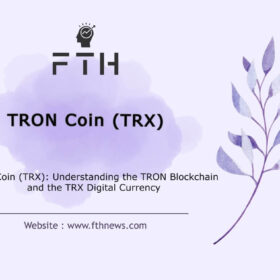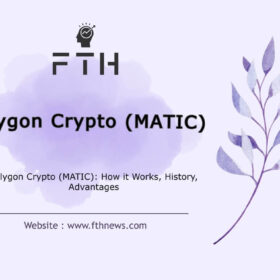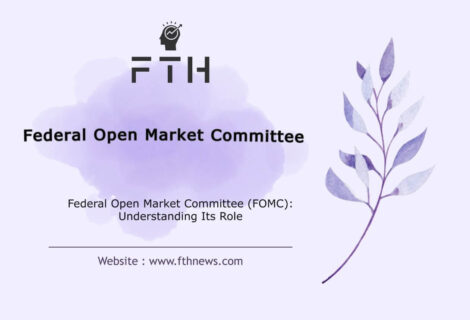
Chainlink and LINK Currency: What It Is, How It Works
Chainlink is not just a digital currency; it’s a decentralized network of nodes operating on the Ethereum blockchain, facilitating the transfer of real-world data to smart contracts through Oracles. Smart contracts, in turn, automatically execute predefined actions based on conditions met within the blockchain. At the core of the Chainlink network is its native digital currency called LINK. This currency serves a dual purpose: paying fees for interactions with oracles and smart contracts, and rewarding nodes that contribute valuable data.
Chainlink is Connecting the Blockchain with the Real World
History of Chainlink and LINK Currency
The inception of Chainlink dates back to 2014, with its official launch occurring in 2017. Initially conceived as a centralized oracle system, the network evolved into a decentralized ecosystem of oracles connecting to smart contracts, using external data sources and APIs to enhance the security of transactions.
Particularly noteworthy is the openness of the Chainlink network. It operates on a permissionless model, allowing anyone to join and contribute data by running a node. Participants are incentivized through LINK token rewards, the native digital currency of the Chainlink network.
Founders of Chainlink: Pioneers in Blockchain Innovation
At the helm of Chainlink Labs is Sergey Nazarov, the co-founder and CEO. A graduate in business management with a focus on philosophy and management from New York University, Nazarov’s journey commenced with teaching at NYU’s Stern School of Business. In 2009, he launched ExistLocal, a peer-to-peer marketplace for local environmental experiences. Nazarov’s contributions expanded with the creation of CryptoMail in 2014, a fully decentralized blockchain-based email service.
In the same year, Nazarov, alongside Steve Ellis, co-founded the SmartContract platform. This platform breathed new life into smart contracts by linking them to external data and widely accepted payment methods. This entrepreneurial venture laid the groundwork for the eventual launch of Chainlink.
Steve Ellis, a 2010 graduate in Computer Science from New York University, started his career as a software engineer at Pivotal Labs. In 2014, he founded Secure Asset Exchange, a company facilitating easy web access to decentralized asset exchanges.
The combined expertise of Nazarov and Ellis has played a pivotal role in the evolution and success of Chainlink, positioning it as a leader in connecting blockchain technology with real-world data. In the following sections, we’ll delve into a historical overview, conduct a future price analysis, and provide insights on how to buy and sell LINK cryptocurrency. Stay tuned for a comprehensive exploration of the Chainlink ecosystem.
The Reason for the Invention of Chainlink: Bridging the Smart Contract Gap
Smart contracts, the backbone of blockchain technology, operate within predefined conditions and data to reach final decisions. Immutable and verifiable, these contracts face limitations when dependent on data beyond the blockchain. The challenge arises when attempting to integrate off-chain data into on-chain smart contracts, given the disparity in languages.
Chainlink was conceived to address this critical gap by introducing a decentralized oracle network. Oracles, acting as intermediaries, play a pivotal role in translating external data into a language comprehensible to internal smart contracts. This innovative solution facilitates the seamless integration of off-chain information, expanding the utility and capabilities of smart contracts.
Understanding the Chainlink Network and its Functionality
Chainlink, as a cryptocurrency blockchain, acts as a bridge between real-world information and smart contracts on the Ethereum blockchain through a decentralized network of oracles. To grasp the workings of the Chainlink network, it’s essential to delve into the concepts of oracles, smart contracts, and the off-chain and on-chain architecture that underpins this innovative system.
Oracle: The Middleman of Blockchain
In essence, an Oracle is a form of middleware—a software intermediary that facilitates the translation of real-world data into smart contracts on the blockchain and vice versa.
Acquiring External Information via Chainlink Oracles and Transmitting it to Smart Contracts
Oracles significantly enhance the robustness of the network protocol by safeguarding, validating, and fortifying the unique credibility of data received and utilized by a blockchain network. This is especially crucial because blockchains and smart contracts operate within closed systems. Oracles can be decentralized, relying on diverse datasets, or centralized, under the control of a central unit. Presently, the primary application of blockchain-based oracles lies in providing the necessary data feed and pricing for executing smart contracts, particularly in the decentralized finance sector (DeFi).
Smart Contracts: Automated Agreements on the Blockchain
A smart contract represents a pre-established agreement on the blockchain that automatically evaluates information and executes when specific conditions are met. An illustrative example is crowdfunding, where, for instance, if a designated amount of Ether is deposited into a smart contract by a certain date, payments are released accordingly. In the absence of meeting these conditions, payments revert to the donors.
Given that smart contracts reside on the blockchain, they are immutable yet verifiable. This immutability ensures a level of trust between parties involved. However, for smart contracts to create agreements extending beyond the data within the blockchain, they require both off-chain and on-chain data in compatible formats. Bridging the gap between external information sources and smart contracts on the blockchain, in a language comprehensible to both, poses the primary challenge in this context.
In the following sections, we will explore the historical evolution of Chainlink, analyze its future price trends, and guide you through the process of buying and selling LINK cryptocurrency. Stay tuned for a comprehensive journey into the intricacies of the Chainlink ecosystem.
Chainlink On-chain Architecture: A Deep Dive
The interaction between smart contracts and oracles within the Chainlink ecosystem is a meticulous process initiated by a smart contract sending a “Requesting Contract” to obtain external information. The Chainlink protocol, facilitating the reception of this information, registers the request as an “event” and generates a Service Level Agreement (SLA) contract. The SLA contract, in turn, gives rise to three essential subcontracts:
Reputation Contract: This contract meticulously records the performance metrics of the Oracle. Metrics include the total number of completed requests, average response time, and the amount of LINK cryptocurrency staked by the Oracle.
Order-Matching Contract: Responsible for collecting Oracle proposals based on the SLA, this contract evaluates the data and selects proposals using the reputation contract, finalizing the Oracle’s SLA.
Aggregating Contract: Validating the integrity of an Oracle by examining its history, the aggregating contract collects Oracle responses and calculates the final collective result of the Chainlink query. Additionally, it relays Oracle metrics to the reputation contract.
Facilitating Communication in Three Steps:
To ensure seamless communication between users and external data sources, the Chainlink network follows a three-step process employing these smart contracts:
Oracle Selection: Users, designated as “Oracle service buyers,” draft an SLA with desired requests. The buyer, utilizing the reputation contract, sorts, filters, and selects Oracles. The SLA is then registered in an order-matching agreement, eliminating the need for direct communication with Oracles.
Data Reporting: After recording the SLA in the order-matching agreement, Oracles review and filter requests based on their capabilities. Chainlink nodes select proposals to provide the service. To ensure commitment, Oracles stake Chainlink’s digital currency in the network, subject to confiscation in case of non-compliance or misbehavior as per the SLA.
Result Aggregation: Oracles execute the agreement and report results to the on-chain. The aggregating contract counts and calculates weighted responses, and the validity of each Oracle response is reported to the reputation contract.
Chainlink Off-chain Architecture: Bridging the Blockchain and Real World
The LINK cryptocurrency network extends its reach beyond the blockchain through oracles connected to the Ethereum network. Operating independently, these oracles are responsible for collecting real-world data requested by contracts, providing responses to off-chain requests. This process involves two vital components:
ChainLink Core: The core node software reads new SLAs and directs tasks to the ChainLink adapter.
ChainLink Adapter: Serving as a bridge between nodes and external data, the adapter reads, processes, and writes data to the blockchain. This off-chain architecture ensures the seamless integration of real-world information into the blockchain, enhancing the capabilities of Chainlink.
Understanding LINK: Chainlink’s Digital Currency
In the Chainlink network, the digital currency utilized is LINK, adhering to the ERC677 standard, which operates similarly to the ERC-20 standard. As previously mentioned, Oracle service providers are mandated to stake LINK tokens in the network to ensure the prevention of misbehavior and erroneous operations. Nodes that fulfill their responsibilities by delivering accurate data from external sources to blockchain smart contracts are duly rewarded with LINK tokens. The buyers or users requesting these services compensate the nodes, and the pricing for each service is determined by the data provider or Oracles during the service offering.
The total and maximum supply of LINK tokens is capped at 1 billion units, with 467,009,549.52 units currently in circulation as of March 24, 1400. The LINK cryptocurrency is presently trading in the range of $13.14, boasting a market value of $6.1 billion, securing its position as the 23rd highest-ranking digital currency in the market.
Chainlink’s International Affiliation: Origins and Headquarters
The question of LINK’s country of origin can be approached in two ways. In terms of the creators’ nationality, Sergey Nazarov, the founder of the Chainlink project, is a Russian entrepreneur. However, if the query pertains to the location of the company supporting the network and its digital currency, Chainlink Labs, it’s essential to note that the company is registered in the city of San Francisco in the United States, establishing it as a private American company.
Advantages of Chainlink: Empowering Smart Contracts
Chainlink, designed to facilitate the integration of off-chain data for smart contracts, offers several key advantages, enhancing the capabilities of blockchain technology:
Connecting to Various APIs: Chainlink Core serves as a crucial component, translating data requests from on-chain programming languages to off-chain languages. This empowers smart contracts to securely access decentralized resources, ensuring accuracy and reliability. Smart contracts can now request data from any external source, fostering flexibility and security.
Global Payment Transactions: By providing smart contracts with access to external information sources, Chainlink enables the creation of stronger and more versatile contracts. This newfound capability allows for the seamless execution of payments worldwide through Oracle’s decentralized networks.
Decentralization: Chainlink is inherently decentralized, operating on a blockchain foundation. This decentralization ensures that no single entity, including governments or large corporations, holds control over its operations. This characteristic enhances the trust and autonomy of the Chainlink network.
End-To-End Encryption: Operating exclusively within the blockchain domain, the entire Chainlink system, including Oracle Networks, employs end-to-end encryption. This not only safeguards the correctness of collected data but also shields the location of smart contract information, preventing exposure to external sources.
Increasing Efficiency of Smart Contracts: Historically, the secure access of Chainlink to external resources was limited. However, with the ability to connect smart contracts to an array of input and output data, the efficiency and potential of smart contracts have witnessed a significant boost. Chainlink opens the door to more expansive and intricate applications.
Continuous Project Improvement: The Chainlink project is dedicated to ongoing enhancement. The support group consistently strives to augment efficiency by introducing new features. This commitment has instilled confidence in numerous companies and businesses, fostering increased trust in the capabilities of smart contracts.
Secure Storage in LINK-Compatible Wallets
Chainlink’s LINK token operates on the Ethereum network and adheres to the ERC677 standard, which is functionally similar to ERC20. Consequently, any wallet supporting the Ethereum network is suitable for storing Chainlink’s digital currency. Notable software wallets such as Trust Wallet, Atomic Wallet, MetaMask, and MyEther Wallet are among the best options for securely storing, buying, and selling LINK.
For those seeking hardware wallet compatibility, options include Ledger, Trezor, Safe Pal, Kip Key, and others. These wallets provide an added layer of security for users looking to safeguard their LINK holdings.
Chainlink 2.0: Unveiling Decentralized Oracle Networks (DONs)
The foundation of Chainlink 2.0 lies in the introduction of Decentralized Oracle Networks (DONs). DONs are networks maintained by a committee of Chainlink nodes, offering robust support for various Oracle functions selected by the committee. This innovative approach positions DON as a powerful abstraction layer, providing interfaces to seamlessly connect smart contracts to a diverse array of off-chain resources and highly efficient yet decentralized computing resources within DON itself.
In the Chainlink 2.0 cryptocurrency network, seven key goals have been defined to enhance its capabilities:
Hybrid Smart Contracts: Introducing a versatile framework that improves existing smart contract capabilities by securely integrating on-chain and off-chain computing resources within hybrid or dual smart contracts.
Removal of Complexity: Streamlining functionality for developers and users, eliminating the need to navigate complex system limits and protocols.
Scalability: Ensuring that Oracle services meet the latency and throughput requirements demanded by high-performance decentralized systems.
Privacy: Enabling next-generation systems that blend the inherent transparency of blockchain with robust privacy capabilities for handling sensitive data.
Order Fairness for Transactions: Supporting fair transaction sequencing for users, preventing issues like front-running and other attacks by bots and profit-seeking miners.
Minimizing the Need for Trust: Constructing a highly trusted layer for smart contracts and other systems independent of oracles, relying on decentralization, robustness, secure blockchains, cryptographic techniques, and crypto-economic guarantees.
Incentive-Based Security (Crypto-economy): Implementing strong mechanisms that incentivize DONs nodes for safe and correct behavior, establishing a secure and resilient network.
Fees and Expenses in Chainlink: Navigating Transaction Costs
In the Chainlink network, average transaction costs are nominal, typically constituting a fraction of one percent. However, these costs may escalate in tandem with increases in currency prices and the demand for off-chain data to execute smart contracts.
For those engaging in LINK cryptocurrency trading on exchanges, it’s crucial to be aware of varying cost structures and fees. Transaction fees range from a minimum of 0.1% to potentially reaching 0.2% of the total transaction amount. Withdrawal fees also differ among exchanges, sometimes reaching up to 0.7 LINK. In certain instances, withdrawal fees might be as high as 0.10 LINK per transaction.
Potential investors in LINK should conduct thorough research on trading fees, commissions, withdrawal fees, and other associated costs before selecting a trading platform. Prudent consideration of costs is essential to safeguarding profits, as high fees have the potential to erode gains.
Chainlink Security:
Chainlink prioritizes security, leveraging a robust blockchain foundation to safeguard transactions and information. Here’s an in-depth look at the security features:
Immutable Blockchain: Transactions and data archived in the Chainlink blockchain are immutable, meaning they cannot be altered once recorded. Changes require consensus from all nodes, ensuring the integrity and security of the blockchain.
Consensus-Driven Security: Modifications within the Chainlink blockchain are governed by consensus among all participating nodes. This decentralized decision-making process adds an extra layer of security, mitigating the risk of unauthorized alterations.
Encryption Shield: Chainlink employs advanced encryption measures, enhancing protection against cyber threats and potential attacks on the blockchain. This encryption acts as a shield, securing Link tokens and the sensitive information processed within the network.
Secure Cryptocurrency Management: Investors in Link cryptocurrency are advised to enhance security by opting for hardware or software wallets. These wallets provide an additional layer of protection, minimizing the potential risks associated with cryptocurrency assets.
Chainlink Mining: A Distinctive Approach
Chainlink adopts a unique approach to token acquisition, differing from traditional mining models:
Buying and Selling Data and Services: Participants can acquire Link tokens by engaging in the buying and selling of data and services off-chain through APIs associated with the Chainlink network. This dynamic method allows users to contribute to the ecosystem and earn Link tokens through data-related transactions.
Exchanges: Link tokens (LINK) can also be obtained through various digital currency exchanges. Users have the flexibility to exchange or purchase LINK on these platforms, offering accessibility for those seeking to acquire or trade Link tokens.
By intertwining advanced security measures with innovative token acquisition methods, Chainlink establishes itself as a secure and adaptable player in the blockchain arena, catering to the needs of both investors and contributors within its network.
Conclusion
In conclusion, Chainlink stands out as a robust blockchain project built on Ethereum. It operates as a decentralized network of oracles facilitating the integration of real-world information into smart contracts. The native digital currency of the Chainlink network is LINK, serving the dual purpose of paying fees for interacting with smart contracts and rewarding oracle nodes. The evolution to Chainlink 2.0, with the introduction of Decentralized Oracle Networks, reflects the project’s commitment to advancing the capabilities of smart contracts and decentralized systems.
FAQ
Yes, Chainlink is considered a promising investment due to its role in facilitating smart contracts with real-world data.
Chainlink is used to connect smart contracts with real-world data, enabling them to execute based on external information
Chainlink’s value lies in its ability to enhance smart contracts by securely integrating external data, expanding their use cases.
Yes, Chainlink is positioned for continued growth, driven by its unique role in bridging blockchain and real-world data.
Chainlink and Ethereum serve different purposes. Chainlink facilitates data integration for smart contracts, while Ethereum is a broader blockchain platform. They can complement each other in decentralized applications.














